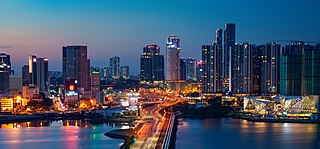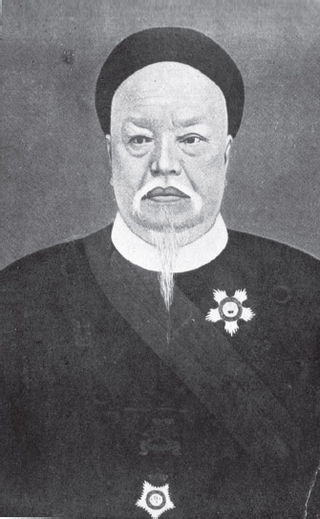
Chaozhou, alternatively Chiuchow, Chaochow or Teochew, is a city in the eastern Guangdong province of China. It borders Shantou to the south, Jieyang to the southwest, Meizhou to the northwest, the province of Fujian to the east, and the South China Sea to the southeast. It is administered as a prefecture-level city with a jurisdiction area of 3,110 km2 (1,200 sq mi) and a total population of 2,568,387. Its built-up area encompassing most of Shantou and Jieyang cities was home to 12,543,024 inhabitants on 13 local administrative areas. Along with Shantou and Jieyang, Chaozhou is a cultural center of the Chaoshan region.

Johor Bahru, colloquially referred to as JB, is the capital city of the state of Johor, Malaysia. It is located at the southern end of Peninsular Malaysia, along the north bank of the Straits of Johor, opposite the city-state Singapore. The city has a population of 1,306,099 people within an area of 391.25 km2. Johor Bahru is adjacent to the city of Iskandar Puteri and Pasir Gudang, together with their surrounding areas anchoring Malaysia's second largest urban agglomeration, Iskandar Malaysia, with a population of 2,246,712.

Sultan Sir Abu Bakar Al-Khalil Ibrahim Shah ibni Almarhum Temenggong Seri Maharaja Tun Daeng Ibrahim was the Temenggong of Johor. He was the 1st Sultan of Modern Johor, the 21st Sultan of Johor and the first Maharaja of Johor from the House of Temenggong. He was also informally known as "The Father of Modern Johor", as many historians accredited Johor's development in the 19th century to Abu Bakar's leadership. He initiated policies and provided aids to ethnic Chinese entrepreneurs to stimulate the development of the state's agricultural economy which was founded by Chinese migrants from Southern China in the 1840s. He also took charge of the development of Johor's infrastructure, administrative system, military and civil service, all of which were modelled closely along Western lines.

Lim Chu Kang is a planning area located in the northwestern part of the North Region of Singapore, bordering the Western Water Catchment to the west and south, Sungei Kadut to the east and the Straits of Johor to the north.

Chinese Singaporeans are Singaporeans of Chinese descent. Chinese Singaporeans constitute 75.9% of the Singaporean citizen population according to the official census, making them the largest ethnic group in Singapore.

William Alexander Pickering was the first Protector appointed on 3 May 1877 by the British government to administer the Chinese Protectorate in colonial Singapore. He was the first European official in Singapore who could speak fluent Mandarin and Hokkien and gained the trust of many of the Singapore Chinese. His efforts went a long way towards controlling the problems posed by the secret societies then. Pickering Street in Singapore's Chinatown is named after him.

The Sun Yat Sen Nanyang Memorial Hall, also known as Wan Qing Yuan, and formerly as the Sun Yat Sen Villa, is a two-story colonial style villa in Balestier, Singapore. The villa is now a museum commemorating Sun Yat Sen (1866–1925), the founding father of the Republic of China who visited Singapore nine times between 1900 and 1911.

Seah Eu Chin was an immigrant from South China to Singapore, later becoming a successful merchant, a prominent descendant of Seah Clan and leader in the Overseas Chinese community.

The House of Tan Yeok Nee is a mansion building located at the junction of Penang Road and Clemenceau Avenue in the Museum Planning Area in Singapore. After an extensive restoration completed in 2000, it was held by the University of Chicago Booth School of Business. As of 2019, the building serves as the Singapore campus for Amity Global Institute.
Four Mansions were four elaborate Chinese-style mansions built by four Teochew businessmen in the late 19th century in Singapore.

Jumbo Seafood is a Singaporean restaurant chain specialising in the seafood aspects of Singaporean cuisine and dishes, such as Chili crab. First opened in 1987 with an outlet at the East Coast Seafood Centre modeling and taking design elements similar to the non affiliated JUMBO Floating Restaurant Hong Kong, Jumbo Kingdom. It became a hit, it then opened an additional five outlets throughout the country including in the suburban areas of Serangoon Gardens as well as the Singapore Indoor Stadium. As of 2022, it has 5 outlets in Singapore.

The Kangchu system was a socio-economic system of organisation and administration developed by Chinese agricultural settlers in Johor during the 19th century. The settlers organised themselves into informal associations, and chose a leader from among themselves.

Kovan is a neighbourhood located within the town of Hougang, in the North-East Region of Singapore. The neighbourhood today largely consists of private housing properties, where majority of the residents live in terrace homes, semi-detached houses and bungalows.
Low Kiok Chiang, also known as Jacob to his contemporaries, was a successful businessman and prominent Roman Catholic Church philanthropist in the late 19th and early 20th centuries in Singapore, Thailand and China.

Major China Dato' Tan Hiok Nee, also known as Tan Yeok Nee, was the leader of the Ngee Heng Kongsi of Johor, succeeding Tan Kee Soon in circa 1864, he transformed the Ngee Heng Kongsi of Johor from a quasi-military revolutionary brotherhood, based in the rural settlement of Kangkar Tebrau, into an organisation of kapitans, kangchus, and revenue farmers, based in the state capital of Johor Bahru. His grandson Tan Chin Hian, was the chairman of the Singapore Chinese Chamber of Commerce, Singapore Teochew Poit It Huay Kuan and Ngee Ann Kongsi Singapore for many years.

Wong Ah Fook J.P.,, also known as Wong Fook (黄福) or Wong Fook Kee (黄福基), was a Chinese immigrant, entrepreneur, and philanthropist who left an indelible imprint on the state of Johor in present-day Malaysia, particularly its capital, Johor Bahru. Primarily a building contractor, although he also ventured into many other businesses, he built a good number of Johor's heritage buildings, including the original Istana Besar, the royal palace of the Sultan of Johor. Jalan Wong Ah Fook, one of the busiest streets in downtown Johor Bahru, is named after him.

Kapitan China Lim Ah Siang, a timber merchant and steam saw miller, the founder of "Chop Sin Moh" Johor Bahru, was the third leader of the Ngee Heng Kongsi of Johor, a legitimised secret society based in Johor Bahru. He was appointed to the position not because he was the most prominent Chinese in Johor at the time but rather, because he was not.
Ngee Heng Kongsi of Johor was a Teochew secret society that founded the earliest Chinese settlement in Johor. However, it did not have a clandestine image and has instead been accorded a respectable place in the history of the Johor Chinese. The term kongsi generally refers to any firm or partnership, and has also been used to refer to any group or society in a very broad sense. Ngee Heng is the Teochew name for the Ghi Hin or Ghee Hin, its name in Hokkien. The name identifies it as the Teochew offshoot of the Tiandihui secret society.
Pearl's Hill, briefly Mount Stamford, is a small hill in Singapore. Located in the vicinity of Chinatown, it is one of the few surviving hills in the city area.
Tan Seng Poh, was a chairman of the Singapore Municipal Committee, a Justice of the Peace and an honorary magistrate.















